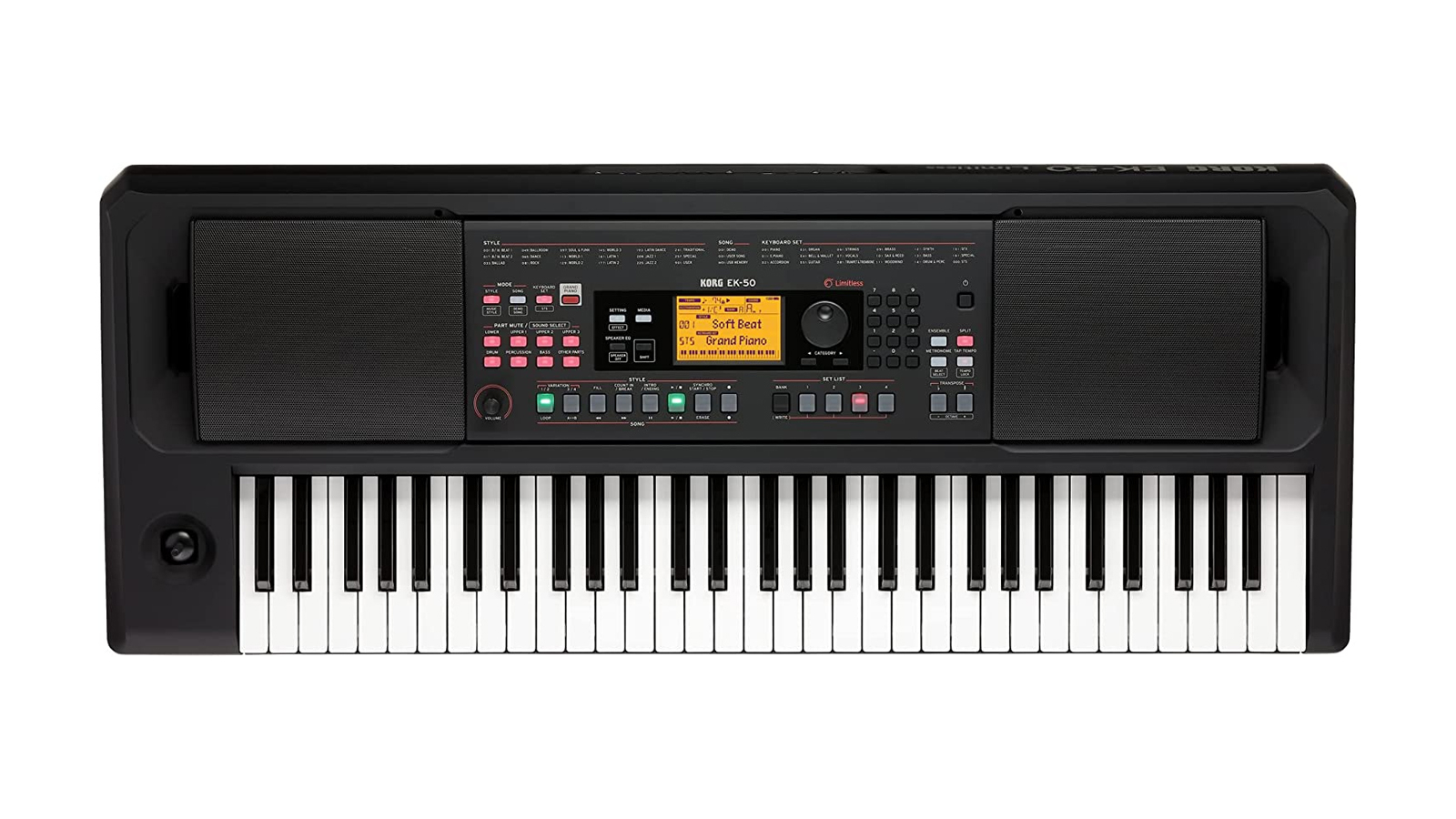MusicRadar Verdict
It’s an inescapable fact of life that, as a product type, arranger keyboards sometimes have a tendency to suffer from a hint of cheesiness. Naturally, the EK-50 is perfectly capable of entertaining a roomful of retirement home residents, but with its generous variety of onboard arrangement styles, rhythms and parts, it’s equally a great source of fun for hobbyists, kids and beginners.
Pros
- +
Sophisticated arrangement programming
- +
Large array of tones and styles
- +
Great fun to play
Cons
- -
Slightly electronic-sounding grand piano voice
- -
Virtual band is a little self-indulgent at times
- -
Inscrutable interface
MusicRadar's got your back
Korg EK-50 review: What is it?
The Korg EK-50 is a 61-key arranger keyboard aimed at helping you play or perform your favourite songs, with the ‘EK’ part of the name standing for ‘Entertainer Keyboard’. If that conjures up images of playing a programme of Bossa nova favourites to a roomful of OAPs in a retirement home, well that’s just one scenario that this keyboard would be perfect for.
It doesn’t stop there though - with a sophisticated built-in backing band and a generous array of voices and style variations, the EK-50 makes a fun prospect for just about anyone, from intermediate and semi-pro players to beginners and hobbyists who enjoy playing covers of songs in multiple styles. Two powerful 10W speakers, a 40-slot set list function and the fact that it will run for several hours on 8 AA batteries make it a great solution for buskers too.
The EK-50’s footprint is large: the casing extending back far and high, no doubt to be able to accommodate those big 120mm double-cone speakers, and at 7.5 kilos, it’s quite bulky for a portable keyboard, even without the batteries. The speakers flank a central control panel that features a large, info-packed backlit LCD screen and an array of green and red-illuminated control buttons.
A lightweight, wireframe music desk slots into the top, and around the back there’s a 3.5mm headphone output, 3.5mm audio input, two unbalanced 6.3mm line outputs - handy for connecting to PA systems - a 6.3mm foot controller jack and USB to Host and Device ports, which allow connection to a DAW for use as a MIDI controller and to a memory stick for firmware updates and importing extra downloaded styles.
Korg EK-50 review: Performance & verdict
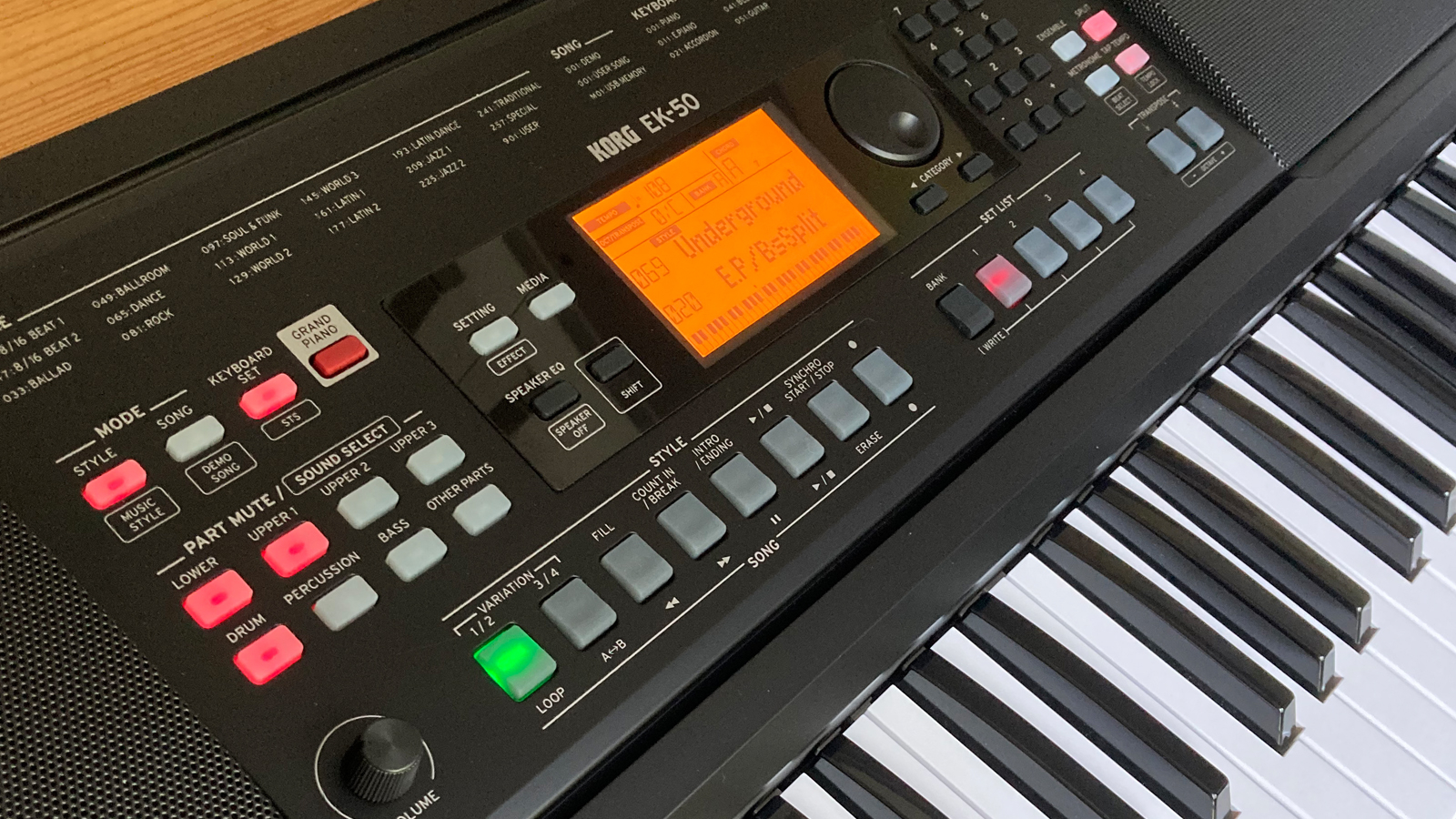
The EK-50’s synth-action keyboard is perfectly playable, and while it doesn’t feel particularly luxurious, it gets the job done without fuss or bother. Those imposing twin speakers chuck out a decent whack of volume and sufficient bottom end for your retirement-home covers of Boom! Shake the Room, and it’s great to have the volume control on a rotary encoder rather than a pair of up/down buttons. Aside from the jog dial used to scroll through the sounds and styles, it’s the only rotary control on the panel.
Interface-wise, the ‘turn on and play’ test was passed - a press of the power button and seconds later I had the default Grand Piano setting beneath my fingers, although for a main acoustic piano voice this had what I felt was a slightly electronic, Yamaha CP-80-esque tang to it. This state can be returned to at any point by pressing the red Grand Piano button on the control panel.
Beyond that, the interface isn’t the easiest to get to grips with - without conventional four-arrow navigation controls or an exit button, on first examination I couldn’t figure out how to change the tempo of the current style (I had to hold down the Shift button and spin the jog wheel to do this) or back out of a mode and get back to the voice selection screen.
Want all the hottest music and gear news, reviews, deals, features and more, direct to your inbox? Sign up here.
Basic adjustments like accompaniment tempo and individual part volume adjustment just aren’t obvious at first, so I resorted to reaching for the quick start guide to help. Volume adjustments seem to be mostly achieved by holding down the button for the function I wanted to adjust and then use the jog wheel to make the adjustment. Simple enough, but from the front panel decals alone, inscrutable enough to cause some head-scratching for new users.
The pale orange backlit LCD display will continually show the chord you’re playing in the top right corner, while a keyboard display along the bottom indicates what notes you’re currently playing, which is useful when you’re trying to work out how to play a song.
Button it
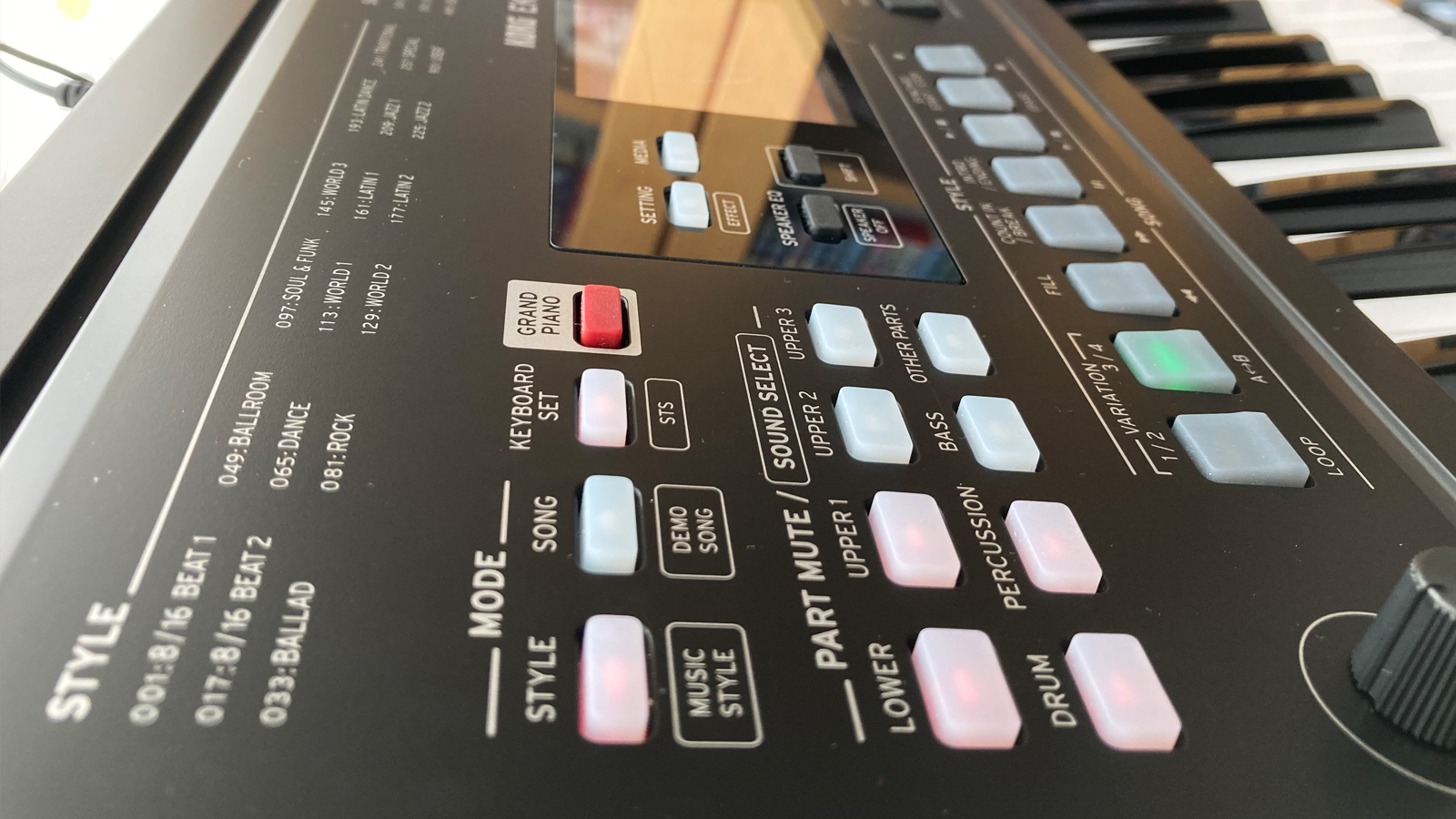

Yamaha PSR E473: 61-key arranger keyboard from Yamaha that features a USB interface, groove creator and over 800 tones
Korg i3: Moving more into workstation territory, the slimmer-profile i3 adds more sounds and an onboard sequencer to the EK-50’s existing feature set.
Casio CT-X5000: Casio’s 61-key arranger keyboard has twin 15W speakers, phrase pads and is compatible with the Casio Music Space app.
Backlit either red or green, the eight rubbery-feeling buttons arranged to the right of the volume control have dual function, depending on whether you have Song or Style mode selected. In Song mode they act as transport controls for recording and playing back the currently selected song, while in Style mode they allow you to select variations of the current style, fills, intros and endings.
You get four variations of 64 backing styles that switch Ableton-like on the next downbeat after you trigger them. Each style can be split into four parts - drums, bass, chords and ‘other’ - all of which can be enabled or disabled with their own on/off buttons. Intros and endings are nicely programmed but often quite comical in that many are eight bars long and play a sequence that has nothing to do musically with what you’ve just been playing.
Elsewhere, the Split button toggles between conventional auto-accompaniment mode (where you shape chords with your left hand and solo with a separate voice in the right hand) and shaping the chords by whatever you’re playing anywhere on the keyboard. If the Split button is not turned on, the whole keyboard will be used to identify the chord you’re playing, but when engaged, only the left portion of the keyboard will trigger the chord recognition. The adjacent Ensemble button harmonises the right hand melody part according to the chord shape your left hand is holding. This is a fairly common feature on arranger keyboards, but the implementation here is excellent.
The EK-50 has the traditional arranger keyboard category headings screen-printed on the central control panel, which went some way towards aiding my efforts to navigate through the long list of preset tones using only the jog wheel and numeric keypad. You can also flick through categories via the dedicated category buttons, while STS mode (Single Touch Setting) helps out by automatically picking a suitable lead sound to accompany whichever style you currently have selected. You can lock the tempo with the tempo lock button so that the tempo will remain the same when switching styles, but there’s no way of editing the onboard styles or creating new ones of your own.
Layer Up
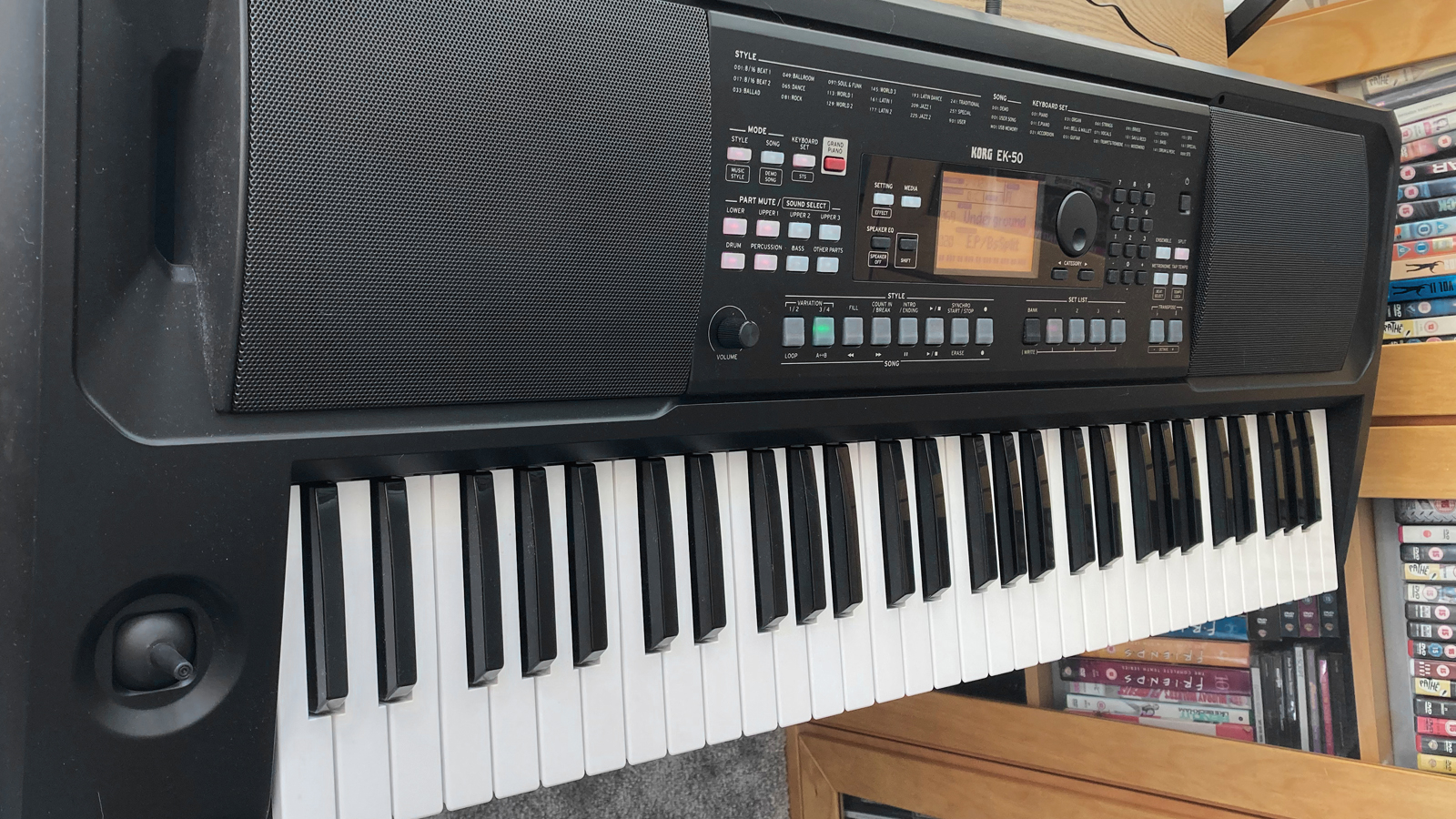
Each keyboard set on the EK-50 is made up of one lower part and three upper parts, which can all be switched on or off independently with the buttons in the Part Mute / Sound Select area. The sets are preprogrammed with sounds that are meant to complement each other, with appropriate effects already applied. Pressing Shift will reveal the sound currently selected in each voice slot, then you can hold the Part button down and use the jog wheel to adjust the volume of that layer.
Handy for gigs, the Set List feature is very easy to use, allowing you to store up to 40 Style and Voice configurations for particular songs. Simply select one of the 10 onboard registration banks, hold down the Write button and press the button for whichever of the four slots in that bank you want to save your current settings to. However, there doesn’t seem to be a way of naming songs or otherwise keeping track of which song occupies which slot.
Final verdict
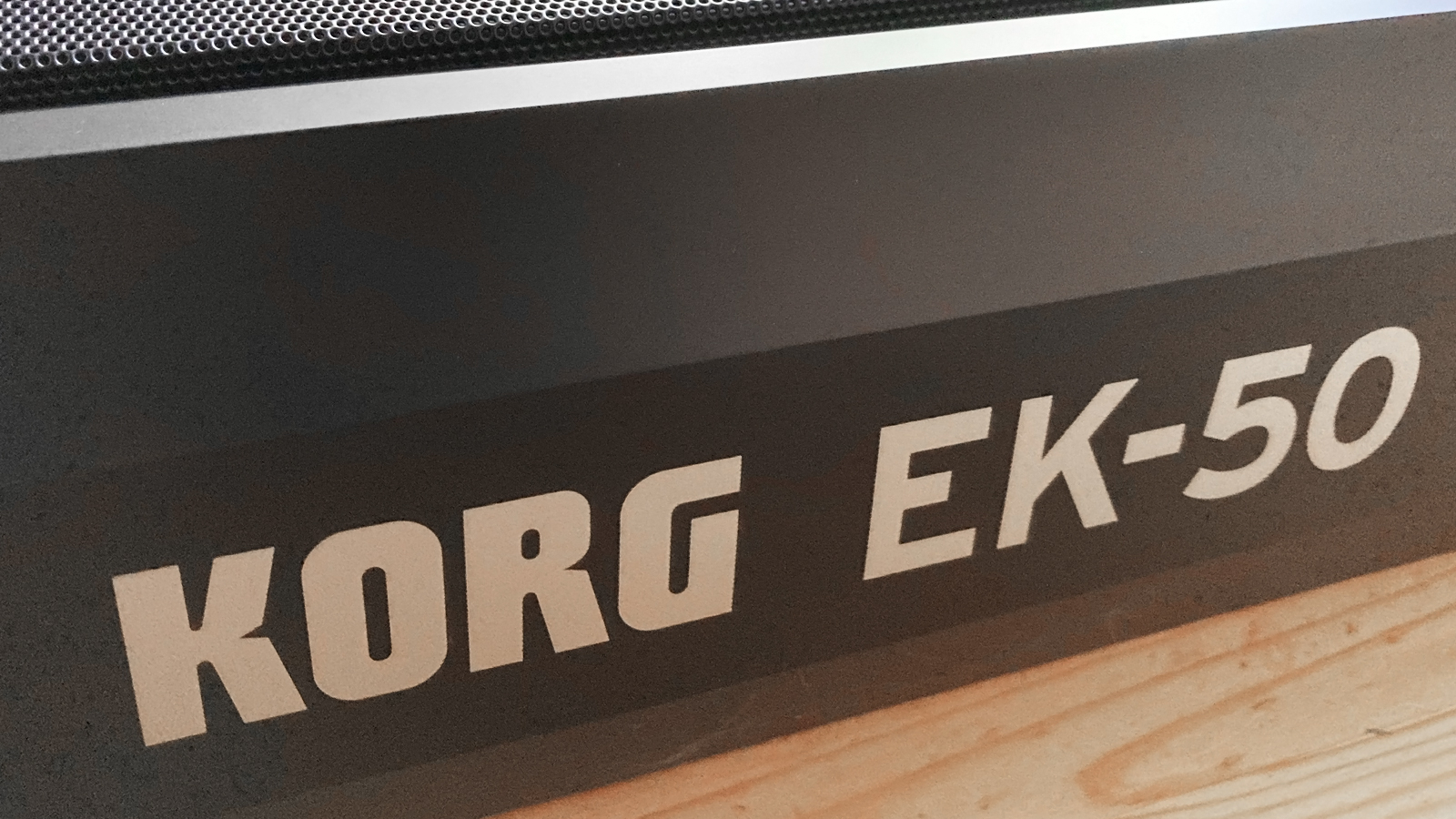
It’s a fact of life that arranger keyboards sometimes have a tendency to suffer from a hint of cheesiness. The EK-50 is capable of entertaining a roomful of retirement home residents, but with its generous variety of onboard arrangement styles, rhythms and parts it’s equally a great source of fun for hobbyists, kids and beginners. The chord readout function alone is educational and creating covers of pop songs on this is a marvellous way to figure out how a successful popular song is structured. Like most arrangers, the onboard virtual band got confused at times and went a bit off-piste, but after figuring out how the accompaniment responds to your input, with a little practice, I was able to put together some pretty convincing covers of songs like Rocket Man, Angels and Careless Whisper.
Overall, I enjoyed my time with the EK-50 very much. The sounds are decent, very ‘Korg’ quality, the accompaniment programming is versatile, sophisticated and nicely arranged, and on a performance-focussed instrument such as this, the joystick is a very welcome addition. With the EK-50 (and its more advanced brother the EK-50L that features more styles and sounds and more powerful speakers), Korg seems to have distilled a generous chunk of the features, sounds and know-how from their more expensive Pa-branded series of professional arrangers into this more affordable, portable unit with the sonic power to punch well above its weight.
Korg EK-50 review: Hands-on demos
Jeremy See
Rimmers Music
Gear4Music
Korg EK-50 review: Specifications
- Dimensions (W x D x H, mm): 994 × 392 × 132
- Weight: 7.5㎏
- Keys: 61 full-size, velocity-sensitive with three levels of touch response
- Polyphony: 64
- Number of Tones: 702
- Number of Rhythms / Styles: 64
- Number of Built-in Songs: 18
- Other features: Auto accompaniment, pitch bend/modulation joystick
- Speakers: 2 x 10W
- Power Supply: 12V DC / 8 x AA Batteries
- Connectivity: 3.5mm headphones jack, 3.5mm audio input, 6.3mm sustain pedal input, 2 x 6.3mm line outputs, USB to Host, USB to Device
- Contact: Korg
Dave has been making music with computers since 1988 and his engineering, programming and keyboard-playing has featured on recordings by artists including George Michael, Kylie and Gary Barlow. A music technology writer since 2007, he’s Computer Music’s long-serving songwriting and music theory columnist, iCreate magazine’s resident Logic Pro expert and a regular contributor to MusicRadar and Attack Magazine. He also lectures on synthesis at Leeds Conservatoire of Music and is the author of Avid Pro Tools Basics.
